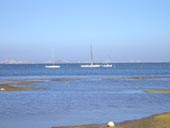
Los Alcazares Apartments – The Beach
Luxurious two bedroom apartment, currently available for holidays on the Mar Menor resort of Los Alcazares, Costa Calida, Spain. Perfectly situated just fifty metres from the beach of Los Narejos, this super Los Alcazares apartment should be ideal for your holiday in this popular area in the Murcia region of Spain. Renowned for its wonderful beaches and excellent golfing facilities, Los Alcazares is also very handy for the airport at San Javier, being just a few minutes drive away, it can also be reached from Alicante airport, though is is a somewhat longer drive. Another of our superb Mar Menor, Los Alcazares apartments, this property offers, 2 bedrooms (sleeps up to 4 people), 1 bathroom, community swimming pool, kid’s pool, fully fitted kitchen, outside terrace with garden furniture, air-conditioning etc. Holiday rentals in this fine apartment are offered from just £255 per week, and long term rentals may be considered as well, should this be your requirement. Los Alcazares has all the usual amenities expected of a modern resort and of course the beach area is the most popular, with warm waters and safe bathing, due to the Mar Menor being a huge enclosed lagoon. Full details of this and other Los Alcazares apartments for rent can be found here: Los Alcazares Apartments.

